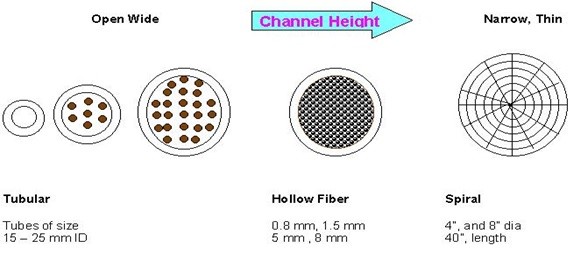PROCESS DESCRIPTION
Ultrafiltration is a tangential flow, pressure driven filtration process that separates particles on the basis of their molecular size. Pore diameters of ultrafiltration membranes are in the range of 10 to 200 A (0.001 to 0.02 micron). Solvents and species having a diameter smaller than the pore size of the membrane will pass through the membrane and emerge as ultrafiltrate known as permeate. Rejected species are progressively concentrated in the retained stream.
Ultrafiltration membranes are reusable and cleanable with standard chemicals.
Ultrafiltration of process water provides
- Removal of virtually all-particulate matter, suspended solids, bacteria, viruses and pyrogenic species from pharmaceutical and industrial process water.
- Removal of colloidal material (non-reactive silica, iron, aluminum etc).
- Removal of high molecular weight organic.
The ultrafiltration membrane is a thin polymeric material (Polyether sulphone) with an anisotropic pore structure. This means the membrane does not have the same pore structure throughout its matrix.
Instead of anisotropic membrane has a surface with small pore diameters and a support structure which has a pore size up to approximately 15 microns. The combination of the very smooth surface with small pores and the support structure with much larger pores results in filtration of small particles with a low resistance to flow.
The difference in pressure between the feed and reject streams will determine the flow of water across the surface of the membrane. The pressure difference between the feed stream and the product side of the membrane is directly related to the product flow. When the pressure is applied to the feed stream, it flows tangential to the membrane surface. Ultrafiltration is a dimensional separation process. Generally ultrafiltration membranes are rated on their Molecular weight Cut off, abbreviated MWCO. This is an indicator of the relative size of the globular molecules which a membrane will remove Indion Membrane systems has ultrafiltration membranes with MWCO ranges between 50000 to 200000. The aqueous phase and material smaller than the membrane’s nominal MWCO will pass through the membrane. Therefore, the product stream will contain water, ionic species and low molecular weight material, whereas the membrane will reject colloidal matter, particle bacteria, viruses, and pyrogenic species.
MEMBRANE CONFIGURATION
Based on construction of the membrane, it is classified into three categories
- Tubular
- Hollow Fiber
- Spiral
The Norit membranes are available in hollow fiber and tubular constructions only.
HOLLOW FIBERS
- Membranes extruded into the shape of a pipe or straw – “fiber” of inside diameter 0.8 mm – 8 mm.
- Many such fibers are bundled together and inserted into a pipe (PVC or Polysulphone).
- Epoxy is injected into the pipe, surrounding the outside diameter of all the fibers.
- Wastewater is pumped into the end of the pipe, and travels through the ID of each fiber. Clean water passes through the walls of each fiber, and collects in the pipe.
- Concentrated solids get accumulated in the fiber in case of dead end filter or discharged through reject in cross flow filter, while clean water is discharged at atmospheric pressure.
Used in low solids concentrations, low disposal cost situation.
ADVANTAGES
- Energy efficient
- Compact
- May be back flushed
- Less prone to plugging than spirals
DISADVANTAGES
- Low temperature resistance
- Prefiltration may be required
WIDE CHANNEL TUBULAR MODULES
- Membrane cast into a porous tube or pipe ½” or 1″ nominal diameter.
- Tubes are mounted in a plastic pipe and then sealed at both ends using double O-rings (1″) or epoxy (½”).
- Tubes are connected in series and parallel to process the required flow rate of liquid.
- Clean water passes through the walls of the tube and exits at atmospheric pressure.
Used in high solids concentrations, high disposal cost situation.
ADVANTAGES
- Durable
- Forgiving
- Accommodates high solids concentrations and large particle size
- May be mechanically cleaned
DISADVANTAGES
- High capital cost
- High energy consumption
- Larger floor space requirements
MEMBRANE CONFIGURATION

APPLICATIONS
- Pretreatment of Reverse Osmosis plant for reduction in SDI
- Removal of colloidal silica
- Bacteria/ Pyrogen removal to get USP grade water
- Concentration of waste coolants
- River water filtration
- Filtration of wines, fruit juice
Click here to check Hydramem Ultrafiltration Membranes: https://hydramem.com/UF.html



